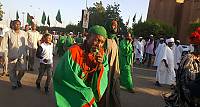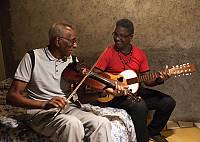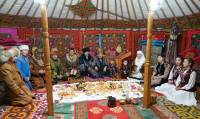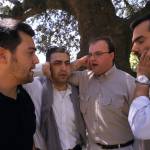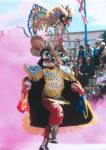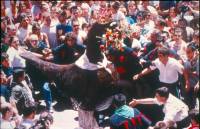
Procession and celebrations of Prophet Mohammed's birthday in Sudan
rces and music corps. During the parade, participants perform religious and mystical songs and ritual dances and recite Sufi prayers. The celebration culminates in al-Molid square, a large open-air space decorated with lights and flags and covered in prayer rugs. Upon arrival, the crowd hangs a flag by a very tall pole. The celebrations are then la... Sudan
Kushtdepdi rite of singing and dancing
ng with vocal improvisation and dancing with movements of the hands, gestures and footsteps in accordance with the tune of the song. The rite serves as a tool for conveying good wishes and is an inseparable part of ceremonies and national celebrations. The bearers and practitioners are the master singers and dancers experienced in the art and able... Turkmenistan
Morna, musical practice of Cabo Verde
choreographic practice with instrumental accompaniment that incorporates voice, music, poetry, and dance. Morna can be either sung or played only with instruments, mainly chordophones, including the guitar, violin, ten-string guitar, replaced with a cavaquinho in the twentieth century, and the ukulele. Several other instruments have now been intro... Cabo Verde
Nawrouz, Novruz, Nowrouz, Nowrouz, Nawrouz, Nauryz, Nooruz, Nowruz, Navruz, Nevruz, Nowruz, Navruz
e early to greet the sunrise of the new year. They light two candles to symbolize happiness and abundance in the new year, fill containers with yogurt, milk or spring water, and cook and eat koje, a traditional Nauryz soup. For the practitioners, Nauryz is a time for settling debts and disputes. The celebrations – which include games, sports comp... Azerbaijan
, India
, Iraq
, Mongolia
, Pakistan
, Türkiye
Canto a tenore, Sardinian pastoral songs
n Sardinia. The most common melodies are the serenade boche ’e notte (’the voice of the night’) and dance songs such as the mutos, gosos and ballos. The lyrics are either ancient or contemporary poems on present-day issues, such as emigration, unemployment and politics. In this sense, the songs can be regarded as both traditional and contempo... Italy
Traditional Vallenato music of the Greater Magdalena region
f cow-herders of the Greater Magdalena region and the chants of African slaves with the traditional dance rhythms of the indigenous people of the Sierra Nevada de Santa Marta. These expressions are also blended with Spanish poetry and musical instruments of European derivation. The lyrics of traditional Vallenato music interpret the world through s... Colombia
(2 February). The traditional llama llama or diablada in worship of the Uru god Tiw became the main dance at the Carnival of Oruro. The Carnival, which takes place every year, lasts ten days and gives rise to a panoply of popular arts expressed in masks, textiles and embroidery. The main event in the Carnival is the procession or entrada. During... Bolivia (Plurinational State of)
eworks and spreading music among the joyous audience. All of these characters join to perform the final dance, the Tirabol. The Patum of Berga, which has preserved its mix of profane and religious features through centuries, stands out from the region’s other festivals that have come down from the Middle Ages owing to its richness and diversity,... Spain
,Gule Wamkulu Gule Wamkulu was a secret cult, involving a ritual dance practiced among the Chewa in Malawi, Zambia, and Mozambique. It was performed by members of the Nyau brotherhood, a secret society of initiated men.Within the Chewa’s traditional matrilineal society, where married men played a rather marginal role, the Nyau offered a means to... Malawi
, Zambia
ragua’s Carazo province. El Güegüense, a synthesis of Spanish and indigenous cultures combining theatre, dance and music, is considered one of Latin America’s most distinctive colonial-era expressions. The earliest texts were probably composed in the early eighteenth century. The story revolves around encounters between the Spanish colonial... Nicaragua
